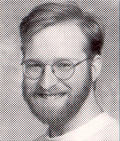
Kenneth Reinert
Thesis Title:
Autofluorescence Imaging of the Cerebellar Cortex In Vivo: Properties, Functions and Cellular Origins
Current Position:
Software Analyst and Computational Neuroscientist, LendPro LLC, Pittsburgh
Former Position(s):
Postdoctoral Associate, Systems Neuroscience Institute
University of Pittsburgh
Major Advisor(s):
- Timothy J. Ebner, M.D., Ph.D.
- Daniel Boley
Research Interests:
My primary research interests are in learning and memory, escpecially in the cerebellar cortex. The lab I am currently working in uses optical imaging techniques to study population level dynamics of the inputs to the cerebellum, climbing fibers from the inferior olive and the mossy fiber/parallel fiber system from the pons, the interactions between them and their plasticity. My current research project focuses on examining the exact timing requirements for parallel fiber-Purkinje cell long term depression (PF-PC LTD) in the cerebellum. The result of this study will resolve a long debate among cerebellar physiologists as to the nature of cerebellar motor learning.
We have recently discovered a new imaging technique involving the use of endogenous fluorescent compounds that are intrinsic to all cells. These compounds, called flavoproteins, are part of the metabolic machinery of the cell's mitochondria. As neurons depolarize, they use signalling molecules such as calcium ions and ADP to signal a change in the energy requirements of the cell. The mitochondria detect these changes and go through a transient oxidative phase to generate the needed energy and then a reductive phase to build up stores for future use. The flavoproteins in the mitochondria fluoresce when oxidized, so we can detect this oxidative phase as an increase in fluorescence in the tissue. Thus we have a non-invasive means of recording neuronal activity at a subcellular level without the need for dyes or contrast agents (see citation below). We are currently using this technique for my LTD timing study as well as a study of the patterns of inhibition on the cerebellar cortex.
Selected Publications:
- Reinert KC, Gao W, Chen G, Wang X, Peng YP, Ebner TJ. Cellular and metabolic origins of flavoprotein autofluorescence in the cerebellar cortex in vivo. Cerebellum. 2011;10(3):585-599.
- Reinert KC, Gao W, Chen G, Ebner TJ. Flavoprotein autofluorescence imaging in the cerebellar cortex in vivo. J Neurosci Res 2007;85(15):3221-3232.
- Gao W, Chen G, Reinert KC, Ebner TJ. Cerebellar cortical molecular layer inhibition is organized into parasagittal zones. J Neurosci 2006;26(32):8377-8387.
- Chen G, Gao W, Reinert KC, Popa LS, Hendrix CM, Ross ME, Ebner TJ. Involvement of
Kv1 potassium channels in spreading acidification and depression in the cerebellar cortex. J
Neurophysiol. 2005; 94(2):1287-98. - Ebner TJ, Chen G, W. Gao W, Reinert KC. Optical imaging of cerebellar functional architectures: parallel fiber beams, parasagittal bands and spreading acidification. Prog Brain Res. 2005;148:125-38.
- Reinert KC, Dunbar RL, Gao W, Chen G, Ebner TJ. Flavoprotein autofluorescence imaging of neuronal activation in the cerebellar cortex in vivo. J Neurophysiol. 2004;92(1):199-211.
- Dunbar RL, Chen G, Gao W, Reinert KC, Feddersen R, Ebner TJ. Imaging parallel fiber and climbing fiber responses and their short-term interactions in the mouse cerebellar cortex in vivo. Neuroscience 2004;126(1):213-27.
- Gao W, Dunbar RL, Chen G, Reinert KC, Oberdick J, Ebner TJ. Optical imaging of long-term depression in the mouse cerebellar cortex in vivo. J Neurosci 2003;23:1859-1866.
